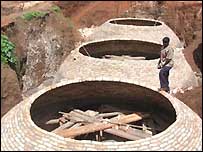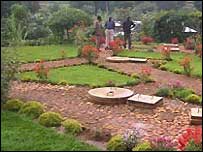Resource 3: Making compost
![]() Background information / subject knowledge for teacher
Background information / subject knowledge for teacher
The best and cheapest way to make garden soil better is to make your own compost. It only costs effort and a little bit of time and care.
Choose an out-of-the-way part of the school garden that is quite sunny. Clear away any weeds and rubbish.
When you have an open space, one of the pupils can mark out a circle with a radius of about 75 cm. If this pupil stands in the centre of the circle and turns around while holding out a walking stick, a good circle will have been drawn.
Take spades and dig up the soil in the circle. Dig to the depth of the blade of the spade. Use a garden fork to make the soil in the circle loose.
Make a small pile of spare soil next to your circle by moving about a third of your loosened soil from the circle.
Stick a central pole or straight branch into the soil in the centre of the circle.
Now you can start the compost-making process. Put a layer of twigs and old leaves you have collected on top of the loose soil. The more you have the better.
Next, put down a layer of stalks and stems from plants and any kitchen waste (potato peelings, old tea bags or tea leaves, eggshells). You can even add shredded scraps of paper.
Then add a dry layer of grass cuttings, dry grass or old dry leaves.
Finish by putting a thin layer of soil on top. Use the loosened soil from the pile next to your compost heap.
Go on adding more layers:
- first stalks, stems, twigs and leaves;
- then kitchen waste and green cuttings;
- then dry grass, old leaves and manure (if you can find it);
- finish each layer with a last layer of soil.
Sprinkle a little water – but don’t make the compost heap too wet.
The height will drop as the matter rots down. Then you can add more layers over time. Always keep a layer of soil on the top – this deters the flies.
Here is an excellent example of the use of compost in a Rwandan prison.
Rwanda award for 'sewage' cooking
A Rwandan prison project, which reduces cooking fuel bills by using methane gas from inmates' toilet waste, has won a global environment award. The Kigali Institute of Science and Technology has helped prisons cut their firewood spending by $44,000 (£25,000). The residue sewage is then used as fertiliser on crops to feed each institution's 10,000 prisoners. ‘Biogas kills two birds with one stone,’ Ainea Kimaro, the Ashden Award winning project head told the BBC. Mr Kimaro received his $53,000 (£30,000) prize at a ceremony in London for underlining the vital role which small-scale sustainable energy can play in tackling both climate change and poverty in Africa, the award organisers said. |  The biogas plants resemble giant brick beehives |
Odour-free
Most biogas plants are small, but Mr Kimaro's big tanks resemble giant brick beehives – constructed in a pit which is covered on completion. Rwanda has a huge prison population with some 120,000 suspects awaiting trial for their alleged part in the 1994 genocide in which some 800,000 Tutsis and moderate Hutus were killed. Five of the country’s largest jails now boast biogas plants, either in operation or under construction. At Cyangugu prison, with biogas now fuelling five of the nine boilers in the prison kitchen, their firewood bill has been cut by more than half. ‘The firewood savings are excellent – they really make a difference for us,’ a Cyangugu prison warden said, adding that the odour-free compost had done wonders for the prison gardens. ‘Look at all these bananas! This fertiliser really is the best,’ he said. Mr Kimaro said the fact that the methane gas was generated from sewage had not put prisoners off their food. ‘I myself have a biogas plant in my house! It's a tropical solution to a tropical problem,’ he said. Adapted from original source: http://news.bbc.co.uk/1/hi/world/africa/4639363.stm |  |
Resource 2: Products from crude oil



